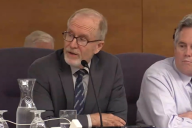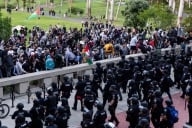You have /5 articles left.
Sign up for a free account or log in.
I’ve been receiving an unprecedented number of calls from presidents across the country asking me to “talk [them] off the ledge.” Most of those conversations have been with presidents whom I judge to be effective and emotionally grounded. Yet each person has been distressed in ways that I didn’t find common during my earlier years in higher education.
In her recent novel, The Devil and Webster, Jean Hanff Korelitz says of her fictional president, Naomi Roth:
From the beginning, she had characterized the job of a college president as, first, doing no harm to the institution, second, improving the institution if at all possible, and third, getting out in one piece. There were bells and whistles, of course, myriad responsibilities, drudgery, absurdities, little challenges like speechifying and remembering names and riding the general rocket that was 21st-century selective admissions in a helicopter parent culture, but at the end of the day the job boiled down to these three.
Like Roth, I was, as the Tacoma News Tribune noted in announcing my appointment in 1992 as president of the University of Puget Sound, “a divorced Jewish woman.” We both also had daughters in college.
But despite those similarities, what struck me most about the book were the differences between my presidential experiences from 1992 to 2003 and those of my contemporaries, on the one hand, and those of Naomi Roth and the many current presidents with whom I talk, on the other. Simply put, although my contemporaries and I often exchanged our own war stories about unhappy moments back then, on balance most of us genuinely took great pleasure in our work. We, too, made lots of speeches, tried hard to remember names, encountered helicopter parents and were sustained by a sense of the absurd, but most of us did not find our work, as Roth does, to be “drudgery.” And I know that I was not alone in being sustained rather than disheartened by my interactions with students, faculty and staff.
It was also a far gentler time. Even as we grappled with perennial matters like admissions, retention, budgets, our physical plants and fund-raising, we didn’t worry -- as current presidents do -- about whether colleges and universities, much less the liberal arts, would survive. The notion of “reputational risk” was a foreign one. Disagreements on campus tended to be confined to the campus.
But that was then, and this is now.
As readers of Inside Higher Ed know, this is a fraught time for many college presidents who are confronting challenges that they did not create and often can’t control.
Many institutions are experiencing financial challenges, often stemming from a cascading decline in enrollments, and the data reveal that these challenges will persist. The number of college-age students in America will continue to decrease for the next several years and will not, in any foreseeable future, return to the numbers we saw before 2011. Growing concerns on the part of the public -- fueled by some elected officials -- that college is unaffordable and/or fails to prepare students for jobs may further dampen interest in college. The “travel ban” has discouraged many international students from enrolling at institutions in the United States.
In response, to attract students, many colleges and universities have had to increase their tuition discount significantly, thereby reducing their net tuition revenue. In 2016, the average tuition discount exceeded 49 percent, compared with 38 percent in 2003.
Institutions that once had prided themselves on collegiality are now divided over matters that previously had not been contentious, such as free speech and academic freedom. Campus events that would previously have been considered standard fare can now quickly become highly politicized and can even present safety concerns. Declining enrollments in the liberal arts have led some administrations and boards to make curricular decisions unilaterally that once had been the primary responsibility of the faculty.
Salary and hiring freezes, layoffs and the closing of long-established programs have also led faculty and staff members to distrust presidents and trustees, sometimes those with whom they had once enjoyed positive relationships. And instead of looking forward to conversations with students, many presidents worry that such encounters will become contentious and uncivil occasions for students to demand large societal changes over which presidents have no influence.
Social media has also significantly raised the possibility of reputational risk. Historically, stories about negative events that occurred on a college campus were most likely to be featured only in the student newspaper and the local press. Today, such stories make their way around the world immediately. Think, for instance, of the painful YouTube videos that have gone viral of college presidents, controversial speakers and even faculty members being subject to the vitriol of protesters, some of whom may not even be members of the campus community.
Recent events reveal how presidents and boards can almost instantaneously be at the center of and ultimately impacted by widely publicized stories about destructive actions on the part of colleagues and students. Baylor University, Penn State University and now Michigan State University have all made clear, in cases involving sexual assault, how vulnerable presidents and trustees are to criticism if they fail to fulfill -- or even if they are perceived to have failed to fulfill -- their responsibly for the health and integrity of the institution in their trust.
Dealing With Presidential Angst
I spoke with a number of worried presidents at this January’s annual meeting of the Council of Independent Colleges’ Presidents Institute. This year, as noted in an article in Inside Higher Ed, “a heightened sense of concern underpinned” much of what took place in both formal sessions and informal conversations: “The concern was evident in the institute's programming, which included a notable number of sessions addressing mergers or partnerships between institutions, as well as strategies for taking on financial challenges.”
Even as I worry on a personal level about these beleaguered presidents, I also worry about what it means for higher education. If talented and dedicated presidents wonder, as many now tell me that they do, if the job is even “doable,” I fear that many potentially excellent candidates will refuse even to consider the presidential role.
So what in these troubled times should college presidents do to function effectively and, at least some of the time, enjoy their work?
Presidents should focus in moments of calm on developing a shared understanding with their boards about who is responsible for which decisions, rather than waiting for a crisis to sort that out. Presidents, other senior administrators and trustees should come together to engage in the kind of exercise that Richard Chait advocates in his article in Trusteeship, “Decisions, Decisions,” to determine which institutional decisions are the responsibility of the president, which belong to the president after discussion with trustees and often with the faculty and other members of the campus community as well, and which should be made by the board after discussion with the president.
Trustees, the administration and the faculty should avoid demonizing one another and come to a common understanding of shared governance, including achieving clarity about who in which circumstances has primary (although not necessarily ultimate) responsibility, who should be consulted and who should be informed about which decisions.
The president and the board should clarify how they will communicate with one another. At some institutions, the president and board chair have regular meetings or calls, but they also need to decide on a protocol for moments of crisis. It is also vitally important that the entire board has confidence that the president will immediately inform the chair about matters of risk and that the chair will, when appropriate, engage trustees in thinking with the president about those matters.
The president and other senior administrators should also be sure that they have effective internal communications. Joined -- by representative faculty members, student affairs staff and, as applicable, campus security professionals, they should engage in robust scenario planning about possible crises on the campus and share the results of that planning with the board. While institutions often do that when it comes to natural disasters, many have not adequately prepared for other possible scenarios, such as:
- Students taking over the president’s office
- Some in an audience shouting down a speaker
- Calls for transparency (which often translate to mean full disclosure) by students and others on matters about which the administration must observe confidentiality for both legal and ethical reasons
- Unsubstantiated but public accusations that one or more people on the campus are racist, homophobic or sexually or otherwise abusive.
This group also needs to decide what relationship campus leaders should have with local law enforcement officers and who speaks for the institution under which circumstances.
Presidents, boards and senior staff should also have a clear understanding of the role of the president in times of crisis. Some experts argue that the president should not be front and center but should delegate interaction with campus constituencies to a vice president. Others believe, as I do, that the president needs to play a visible leadership role, articulating the values of the institution. At the very least, presidents should be fully informed about the circumstances of the crisis, agree with what is being proposed and speak at key moments on behalf of the institution.
Every president should have at least one person knowledgeable about higher education to whom they can turn to discuss such fraught moments confidentially and constructively. Although I would have given similar advice years ago, it is even more vital today that presidents establish relationships with confidants. Those confidants should not only listen and provide moral support but also engage in creative problem solving with the president.
Presidents should intentionally establish and maintain relationships with members of the faculty and staff who will candidly share, both in normal circumstances and moments of crisis, what they think and what they are hearing from others.
Even in the midst of charged and uncertain moments, presidents should exhibit the following characteristics: an unwavering commitment to fairness, a sense of confidence in the strength of their institution and its people, graciousness even when being unfairly attacked, and, if appropriate, empathy for those who believe themselves wronged (which may include parties on all sides of an issue). Presidents should view their role as one of strength but not rigidity and of listening and being responsive. And because most people at the institution will be attuned to their moods and demeanor, presidents should project calm.
Finally, presidents, in both good times and bad, should connect with their campuses. As a matter of ordinary practice, they should take as many walks around the campus as possible, talking informally with students and faculty and staff colleagues. I know of some presidents who have formed strong bonds with people at their institution by dedicating free lunch hours to eating in the school dining hall, joining students, faculty or staff for impromptu conversations. They also attend as many events as possible, such as concerts, plays, lectures, art exhibits and athletic events. Indeed, the best presidents I know view these interactions as one of the perquisites of the job.
My wish for presidents in the current environment is that they become anchored in the life of the campus. Doing so will remind them of the importance of and the reason for the work that they do. It will also enable them to achieve not just President Roth’s goal of “getting out in one piece” but also the fulfillment and pleasure that will sustain them through the challenges as well as the successes.








